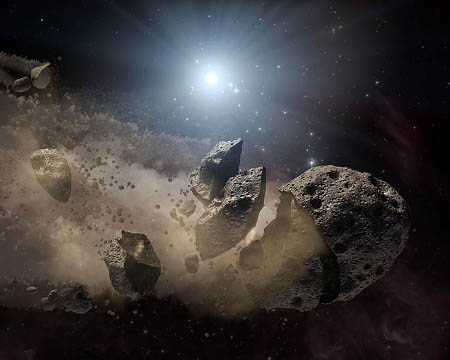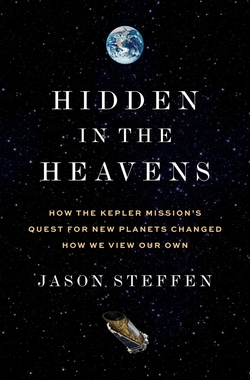The American Astronomical Society meeting now in session in Long Beach (CA) is already making news. Led by Michael Jura (UCLA), a team of scientists has used Spitzer Space Telescope data to study six white dwarf stars that are surrounded with the remains of asteroids. The assumption here is that these materials are a likely indication of planetary formation in these systems, for they’re the same materials that go into making up the Earth and other rocky worlds in our own Solar System.
“If you ground up our asteroids and rocky planets, you would get the same type of dust we are seeing in these star systems,” says Jura, who presented the results at the meeting this morning. “This tells us that the stars have asteroids like ours — and therefore could also have rocky planets.”
When a star like our Sun reaches the end of its life and becomes a red giant, it consumes any inner planets and perturbs the orbits of the surviving planets and asteroids. A white dwarf is the end result of this stellar expansion and subsequent collapse. Objects wrenched out of their former orbits should, like the asteroids in question, occasionally drift close enough to the star to be pulled apart by its gravity. Such a star, showing the excess infrared signature of a circumstellar disk that is likely caused by the tidal disruption of asteroids, is called a ‘polluted’ white dwarf, a total of eight of which have now been studied in detail.
All eight of these stars are thought to show the results of asteroid breakup within the last million years. This is a comparatively new study, one enabled by the fact that asteroids destroyed in this way are broken into tiny pieces that are distinctive compared to asteroid dust around younger stars. The dust is subject to study with Spitzer’s infrared spectrograph, which shows a glassy silicate mineral similar to olivine, commonly found on Earth. “This is one clue,” says Jura, “that the rocky material around these stars has evolved very much like our own.”

Image: NASA’s Spitzer Space Telescope set its infrared eyes upon the dusty remains of shredded asteroids around several dead stars. This artist’s concept illustrates one such dead star, or “white dwarf,” surrounded by the bits and pieces of a disintegrating asteroid. These observations help astronomers better understand what rocky planets are made of around other stars. Credit: NASA/JPL-Caltech.
Also provocative is the lack of carbon in this debris, similar to the low carbon values found in the asteroids and rocky planets of our Solar System. From the paper on this work:
The rocky material in the inner solar system is carbon deficient. In CI chondrites – the most primitive of meteorites – and in Earth’s mantle, n(C)/n(Fe) is 0.9 and 0.009, respectively… Our new data are consistent with the view that extrasolar asteroids are carbon-deficient by a factor of 10 or more… Therefore the building blocks of extrasolar rocky planets have the same substantial carbon deficiency as found in the inner solar system.
Studying the elements present in asteroid dust in visible light should offer up still more information about their relative abundance. Polluted white dwarfs thus offer a window of sorts into how planetary materials are processed around other stars, one that tells us that rocky planet formation should not be unusual elsewhere if in fact materials like these are common in the universe.
The paper is Jura et al., “Six White Dwarfs with Circumstellar Silicates,” in press at the Astronomical Journal and available online.


Systemic blog: HAT found a neptune…
Very nice find =) How far away is this star?
Also, a very interesting find by the HAT team, a transiting Neptune in a 4.8878 day orbit.
http://arxiv.org/abs/0901.0282
The DODO Survey II: A Gemini Direct Imaging Search for Substellar and Planetary Mass Companions around Nearby Equatorial and Northern Hemisphere White Dwarfs
Authors: E. Hogan (1 and 2), M. R. Burleigh (1), F. J. Clarke (3) ((1) Department of Physics and Astronomy, University of Leicester, UK, (2) Gemini Observatory, La Serena, Chile, (3) Department of Astrophysics, University of Oxford, UK)
(Submitted on 5 Jan 2009)
Abstract: The aim of the Degenerate Objects around Degenerate Objects (DODO) survey is to search for very low mass brown dwarfs and extrasolar planets in wide orbits around white dwarfs via direct imaging. The direct detection of such companions would allow the spectroscopic investigation of objects with temperatures much lower ( T8.5 and so could belong to the proposed Y dwarf spectral sequence.
The detection of a planet around a white dwarf would prove that such objects can survive the final stages of stellar evolution and place constraints on the frequency of planetary systems around their progenitors (with masses between 1.5 – 8 solar masses, i.e., early B to mid F).
This paper presents the results of a multi-epoch J band common proper motion survey of 23 nearby equatorial and northern hemisphere white dwarfs. We rule out the presence of any common proper motion companions, with limiting masses determined from the completeness limit of each observation, to 18 white dwarfs. For the remaining five targets, the motion of the white dwarf is not sufficiently separated from the non-moving background objects in each field. These targets require additional observations to conclusively rule out the presence of any common proper motion companions.
From our completeness limits, we tentatively suggest that 500 K between projected physical separations of 60 – 200 AU.
Comments: 24 pages, 34 figures, 5 tables. Accepted for publication in MNRAS
Subjects: Astrophysics (astro-ph)
Cite as: arXiv:0901.0532v1 [astro-ph]
Submission history
From: Emma Hogan [view email]
[v1] Mon, 5 Jan 2009 18:17:58 GMT (501kb)
http://arxiv.org/abs/0901.0532
So carbon planets appear to be rare, at least in the inner regions of solar systems. This is good news for attempts to infer bulk compositions of transiting planets.
Infrared Signatures of Disrupted Minor Planets at White Dwarfs
Authors: J. Farihi, M. Jura, B. Zuckerman
(Submitted on 8 Jan 2009)
Abstract: Spitzer Space Observatory IRAC and MIPS photometric observations are presented for 20 white dwarfs with T less than 20,000 K and metal-contaminated photospheres. A warm circumstellar disk is detected at GD 16 and likely at PG 1457-086, while the remaining targets fail to reveal mid-infrared excess typical of dust disks, including a number of heavily polluted stars.
Extending previous studies, over 50% of all single white dwarfs with implied metal accretion rates dM/dt greater than 3e8 g/s display a warm infrared excess from orbiting dust; the likely result of a tidally-destroyed minor planet. This benchmark accretion rate lies between the dust production rates of 1e6 g/s in the solar system zodiacal cloud and 1e10 g/s often inferred for debris disks at main sequence A-type stars.
It is estimated that between 1% and 3% of all single white dwarfs with cooling ages less than around 0.5 Gyr possess circumstellar dust, signifying an underlying population of minor planets.
Comments: 47 pages, accepted to ApJ
Subjects: Astrophysics (astro-ph)
Cite as: arXiv:0901.0973v1 [astro-ph]
Submission history
From: Jay Farihi [view email]
[v1] Thu, 8 Jan 2009 05:20:05 GMT (229kb)
http://arxiv.org/abs/0901.0973
March 19, 2009
The Sun as a White Dwarf Star
Written by Ian O’Neill
What will happen to all the inner planets, dwarf planets, gas giants and asteroids in the Solar System when the Sun turns into a white dwarf?
This question is currently being pondered by a NASA researcher who is building a model of how our Solar System might evolve as our Sun loses mass, violently turning into an electron-degenerate star.
It turns out that Dr. John Debes work has some very interesting implications. As we use more precise techniques to observe existing white dwarf stars with the dusty remains of the rocky bodies that used to orbit them, the results of Debes’ model could be used as a comparison to see if any existing white dwarf stars resemble how our Sun might look in 4-5 billion years time…
Today, our Sun is a healthy yellow dwarf star. If you want to be precise, it is a “G V star”. This yellow dwarf will happily burn 600 million tonnes of hydrogen per second in its core for 10 billion years, generating the light that is required to make our planet habitable.
The Sun is approximately half-way through this hydrogen burning phase, so it’s OK, things aren’t going to change (for the Sun at least) for a long time yet.
But what happens then? What happens in 4-5 billion years when the supply of hydrogen runs out in the core?
Full article (and some nice artwork and diagrams) here:
http://www.universetoday.com/2009/03/19/the-sun-as-a-white-dwarf-star/
Observational Evidence for Tidal Destruction of Exoplanets
Authors: Brian Jackson, Rory Barnes, Richard Greenberg
(Submitted on 7 Apr 2009)
Abstract: The distribution of the orbits of close-in exoplanets shows evidence for on-going removal and destruction by tides. Tides raised on a planet’s host star cause the planet’s orbit to decay, even after the orbital eccentricity has dropped to zero. Comparison of the observed orbital distribution and predictions of tidal theory show good qualitative agreement, suggesting tidal destruction of close-in exoplanets is common.
The process can explain the observed cut-off in small a-values, the clustering of orbital periods near three days, and the relative youth of transiting planets. Contrary to previous considerations, a mechanism to stop the inward migration of close-in planets at their current orbits is not necessarily required.
Planets nearing tidal destruction may be found with extremely small a, possibly already stripped of any gaseous envelope. The recently discovered CoRoT-Exo-7 b may be an example of such a planet and will probably be destroyed by tides within the next few Gyrs. Also, where one or more planets have already been accreted, a star may exhibit an unusual composition and/or spin rate.
Comments: Accepted for publication to ApJ – 2009 Apr 7
Subjects: Earth and Planetary Astrophysics (astro-ph.EP)
Cite as: arXiv:0904.1170v1 [astro-ph.EP]
Submission history
From: Brian Jackson [view email]
[v1] Tue, 7 Apr 2009 15:31:49 GMT (1295kb)
http://arxiv.org/abs/0904.1170
April 24, 2009
Hubble Discovers a Strange Collection of White Dwarf… Dwarfs
Written by Ian O’Neill
A collection of very odd white dwarfs have been discovered in a local globular cluster. Twenty-four white dwarfs (18 of them are new discoveries) have been spotted. Although these degenerate stars aren’t exactly an uncommon (they are the small sparkling remnants left over after star death), this particular set are unique; they are made from helium, rather than the “standard” carbon and oxygen. And they are small, even smaller than the smallest dwarfs.
How did this dense cluster of old stars evolve? It turns out their stellar material is being stolen, stifling their development…
http://www.universetoday.com/2009/04/24/hubble-discovers-a-strange-collection-of-white-dwarf-dwarfs/